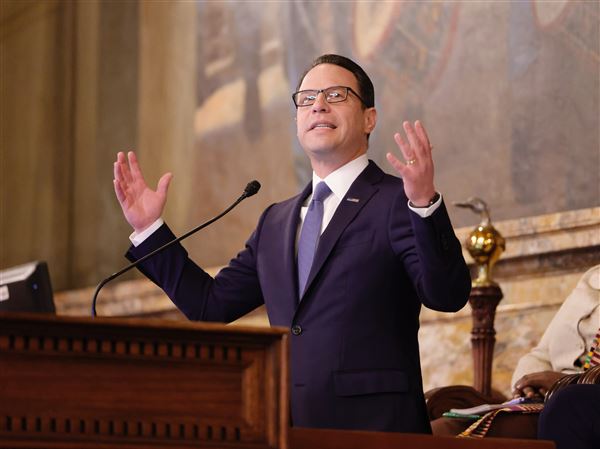
In addition to all his other interests, Franklin had a passion for music.
Click photo for larger image.
Mozart, Beethoven, Haydn ... Benjamin Franklin? Born 300 years ago, Franklin (1706-90) had many talents: author, printer, statesman, diplomat, scientist and inventor. Although it is lesser known, the Philadelphian also had a passion for music.
Franklin played the harp, the violin and the guitar. He printed hymns, wrote a treatise on musical aesthetics, invented a four-sided music stand and attended many concerts. His most significant contribution is the invention of an improved, mechanical version of water-filled musical glasses popular at the time, known as the armonica, or glass harmonica.
Franklin assembled glass bowls of different size on a horizontal rod, which was turned by a foot pedal while the player ran moistened fingers across their edges to create tones. "The invention achieved a certain popularity in America but exercised far more influence in Europe," writes the New Grove's
Dictionary of Music and Musicians. Even Mozart wrote for it.
But was Franklin also a composer? A Pennsylvania professor of music thinks so, and he wants to add that vocation to the Founding Father's impressive resume.
Kenneth Sarch, director of orchestral activities at Mansfield University in Tioga County in north-central Pennsylvania, has revived an old debate on whether Franklin wrote a most unusual string quartet while living in Paris around 1778. If it were true, it would add even more richness to the legend of America's celebrated polymath in this, the tricentennial of his birth.
The first movement of String Quartet, ""Open Strings," attributed to Benjamin Franklin:
 String Orchestra version by Kenneth Sarch. String Fling Ensemble, Mansfield University String Camp
String Orchestra version by Kenneth Sarch. String Fling Ensemble, Mansfield University String Camp
 Second movement: Kohon Quartet, Vox
Second movement: Kohon Quartet, Vox
The five-movement quartet is written for the unusual arrangement of three violins and one cello, rather than the format of two violins, viola and cello that had become somewhat standard for string quartets by the late 18th century. But that feature is tame compared to the F-major quartet's most bizarre quality: "[It] calls for all four string instruments to retune to different pitches, creating 16 notes to be played without left-hand fingering, using only the bow," says Sarch, who is creating a performing edition for student orchestra.
This technique is known as scordatura, a retuning of a string instrument to lend different tone and color to the strings (usually to make them sound thinner or brighter). The most famous examples come from Romantic composers Mahler and Saint-Sa?ns. They applied the technique to the violin for supernatural flavor in Symphony No. 4 and "Danse Macabre," respectively. However, even these composers would have thought it unusual to employ scordatura so that no fingering is required. If anything, composers tend to avoid open strings because the timbre is hollow and the player cannot use vibrato.
Just as strange are the quartet's various melodies, which are passed, note by note, around the four players. "If you can imagine four players with four hand bells having to ring one note at a time in different rhythms, that is what this is," says Sarch. Typically, of course, melodies are played on one instrument before they travel to another.
On top of that, the particular 16 notes don't allow for the music to change key or develop harmonically. Says Sarch, "There is no other quartet like it in the history of music that I know of."
Clearly, something fishy is going on here. This is no ordinary piece written for court or concert.
"No serious composer would tolerate such restrictions unless done with tongue in cheek, simply as a musical joke," wrote W. Thomas Marrocco in a seminal study of the quartet in 1972.
This assertion, one of the few issues of consensus among scholars, makes it unlikely that Haydn, Pleyel or Ferrandini composed the work, even though the quartet is attributed to these three well-known composers in various copies peppering Europe. Franklin is given credit for the work in what may be the earliest manuscript, one found in Paris, but it is not in his hand. So it is up to conjecture whether he wrote it.
While Franklin is known to have penned a drinking song in his youth, "there is no evidence that he learned to read music," says Bruce Gustafson, a music professor at Franklin & Marshall College.
Similarly, Franklin frequented the Parisian salon of Mademoiselle Brillon, an accomplished amateur musician. Her soirees would have been the perfect opportunity for Franklin to show off such a quartet, performed by the dilettantes at these parties. However, "there is no mention of it that I have found in the abundant correspondence between Franklin and Mlle. Brillon," says Gustafson, who has done several studies of the Parisian socialite.
The best evidence may be our general knowledge of Franklin. He possessed a genius for puzzles, inventions, chess and mathematics. "Franklin was brilliant and inventive and loved cracking problems and puzzles, so he could well have figured out how to combine some sounds on stringed instruments," says Gustafson.
Franklin's musical beliefs were strong, too, outlined in a short treatise on music and several letters. He preferred clear and simple music that didn't distort the words, and he went so far as to criticize Handel's opera "Judas Maccabaeus" for its misplaced accents, repetition and "screaming."
These facts, combined with Franklin's known predilection for musical gatherings while residing in Paris, would suggest he would have had good reason to impress guests with such a parlor game of a work as the quartet. "It is part of the amusement, to make a piece with this idea," says Sarch. "I can imagine him sitting around in the evening with a couple of his friends trying to make music doing this."
Since no other composer took credit for the piece or has had it attributed to him by later scholars, the quartet may well have been by Franklin. "The only thing in favor of the Franklin attribution is that it was obviously not written by a musician," says Gustafson.
To this point, a contemporary review of the work ravaged it as a "musical farce," a "miserable work" and "degrading to the art." But the rest of this commentary in the Allgemeine Literatur-Zeitung makes it fairly clear the author was most upset by the quartet's refusal to follow established compositional rules. That's a claim conservative theorists and critics have often levied against innovative music over the years. So the quartet is not as bad as the review suggests -- which is not to say it deserves canonization along with Beethoven's revolutionary experiments.
"The music is not very profound and is harmonically quite simple," admits Sarch. "Although not one of our great masterpieces of music, it is a charming and fascinating suite of short dances."
It was most likely the technical aspects of the quartet, rather than the aesthetic qualities, that Franklin (or the composer) hung his hat on.
"[It] is unique in using retuned open strings without fingers," says Sarch. "My feeling is that Franklin was very proud of what he was able to do," he adds. I think he must have taken the manuscript around to different parties and gatherings and said, 'Look at what I have done. Let's try to play this after dinner.' I think it was so much fun and such a hit trying to do these pieces -- just playing open strings with a bow -- that copies were distributed all over Europe."
Sarch first created a performing edition of the work for a conventional string quartet in the '70s, using left-hand fingering to make it easier to play. Actually, he added the fingering to make it possible to play. The called-for retuning, as much as four and five notes higher, would either break today's less flexible synthetic material (gut, often sheep gut, was primarily used in Franklin's time) or simply "be awful-sounding," according to Sarch.
Since then the Sarch has wanted to introduce children to the piece: "Over the years, I said it would be really great to make a version so that school kids could play it, because it is not that difficult to play -- it is just in a weird format."
This year, Mansfield Universityawarded Sarch a grant to create the student orchestra version, using the Paris manuscript as the source. He has been testing it with students at a string camp on campus this month.
Sarch wants the piece to be appreciated or critiqued on its own merits, but he also sees the benefits of where its performance could lead.
"The opportunity to learn about one of our great patriots through music is phenomenal," he says. "If kids could play music that Ben Franklin wrote and then find out about his kite experiment, the glass harmonica, his work with the constitution, [his being] ambassador to France and the rest of it, it would give insight into how his mind and heart worked."
To this end, the mere fact a scribe placed Franklin's name on the top of the quartet in an early manuscript says a great deal about his musical ability. Even if he didn't write this quartet, the attribution addresses Franklin's contemporary reputation as a multitalented genius, and the continued debate says much about how we revere him today.
"The fact any of us can think it possible says a lot about his extraordinary abilities and wide-ranging interests," says Gustafson. "Nothing was impossible for him, it would seem."
Franklin didn't follow every aphorism he penned, but his dabbling in the musical scene in his 70s and 80s shows he adhered to this one: "When you're finished changing, you're finished."

Kenneth Sarch rehearses a possible Ben Franklin composition in Mansfield University's Butler Music Center with summer camp students, from left, Emily Sun of Lansdale, Serena Sarch of Wellsboro and Marsden Cornish of Elmira, N.Y.
Click photo for larger image.
First Published: July 30, 2006, 4:00 a.m.
















